The Year's Most Important Game? Inside the New Skylanders
The most potentially momentous game of 2014 is probably not the one you'd expect.
This article first appeared on USgamer, a partner publication of VG247. Some content, such as this article, has been migrated to VG247 for posterity after USgamer's closure - but it has not been edited or further vetted by the VG247 team.
"We are on the front lines of gaming."
Paul Reiche III doesn't look like the sort to make such bold proclamations. The co-founder of developer Toys for Bob may be the visionary behind one of gaming's single most popular and profitable franchises of the past five years, but he's anything but arrogant. "Whimsical" might be a better term. His Marin-based studio, well removed from the corporate headquarters of publishing giant Activision (who owns the Skylanders brand), appears to be one-half pirate ship and one-half tiki lounge.
A tour of the building involves very little braggadocio about Skylanders' sales or reach or awards; much more attention is given to how difficult it was to get the little thatched roof huts that line the upper level of a converted Novato, CA Air Force hangar to comply with fire code. Where other studios dedicate walls to awards and press clippings, Toys for Bob smothers every surface with drawings and letters from enthusiastic fans, generally ages 7-12. Skylanders is a billion-dollar business, but speaking to its creators you're left with the impression that they're politely baffled by the business side of things.
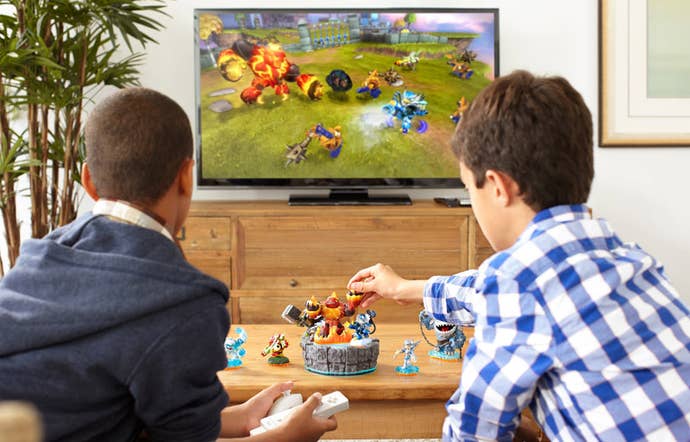
Reiche in particular leaves one with the sensation that, had he not become a formative game designer — the legendary Star Control series was his, and before that he wrote a number of popular Dungeons & Dragons modules throughout the '80s — he probably would have been just as happy as a schoolteacher. He has the same quiet, considerate manner as a great teacher, leaving you with the impression he's listening to your ideas and giving them full consideration. Most of all, though, he genuinely seems to care about children.
"Making games for kids isn't really that different from making games for adults," he told a group of press members assembled at his office for demos a few weeks ago. "You basically just need to change the verbs." Later, when I asked him what he meant by that remark, he laughed self-deprecatingly.
"That was a little obscure, huh? I tend to think about games as verbs and adjectives. Verbs are the actions that you take. Swing sword or jump. Those are common verbs. 'Customize' or 'band together' in an RTS... those are more complex verbs. Kids might not know what 'RTS' means if you say that to them. They'll figure out how it works, you just have to put it in terms that they've already heard. So you can call it a band, or a group, or a team, or something.
"Nouns are the objects, and those can be the physical objects, or they can be just the game entities. You know what a tank is, in character terms, and we can talk about games in terms like tanks or crowd control. And those are great terms. Kids may totally understand how to use those concepts, but if we use those terms we've lost them. So it's about finding ways to directly communicate to someone who hasn't had all our previous experiences and pull them in.
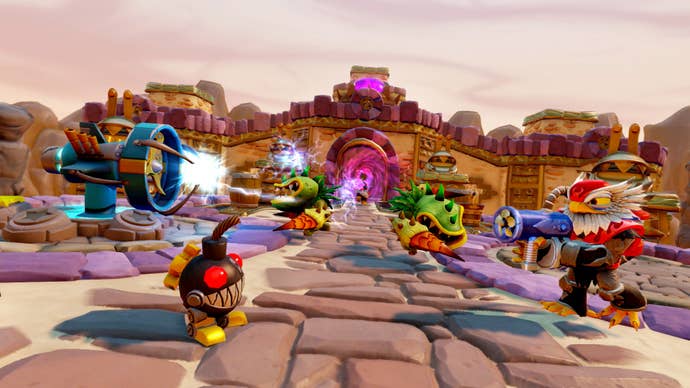
"Skylanders is a role-playing adventure game" Reiche says. "Change the trimmings and it could be a relatively serious game for adults. But we make sure the content is addressable by a younger audience and that we introduce concepts carefully. We may be the first time they've ever solved a jumping puzzle. So you have to make sure it's fun for everybody, but also to make sure that they know what they're doing."
Monstrous regimen
"You have to respect your audience. Treat them as equals."
Respect for the audience can be depressingly rare in video games, but especially those oriented toward kids. Perhaps it helps that Reiche has never entirely lost his boyish enthusiasm for fantasy. "Maybe I'm just a seven-year-old in my head, so maybe I am an equal to all the seven-year-old boys in the world," he jokes. "But we've never gone wrong treating our audience of being sophisticated, intelligent, capable of differentiating high quality. It just feels better to come to the office every day with the mindset of doing your best rather than saying, 'Eh, we could get away with doing it halfway here.'"
Skylanders, with its emphasis on simple action platform gaming, collectible toys, and lumbering cartoon creatures might seem a long way from Reiche's roots as a tabletop role-playing designer and the creator of one of gaming's most timeless space trading sims, but he draws a line from one to the other through the common elements of monsters.
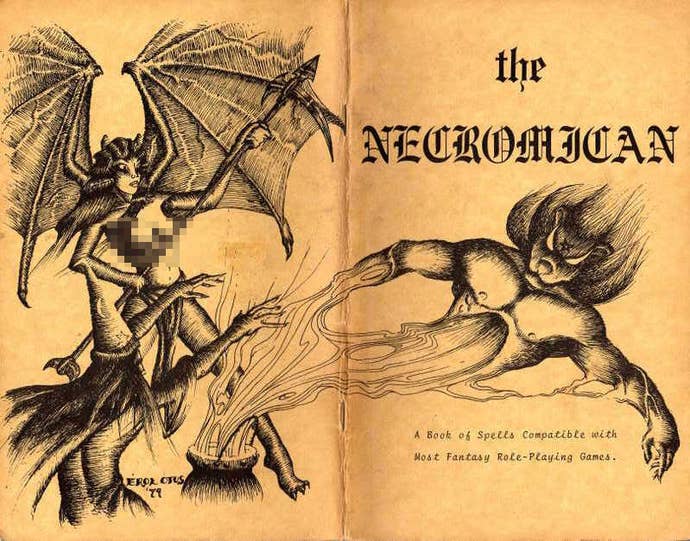
"Even back at TSR, I liked writing content for monsters more than I liked writing for humanoid NPCs," he admits. "I also drifted into Gamma World, because it was so wacky, so crazy and colorful. I really love pulp science fiction. I really love color and vibrancy. So, for me, monsters give you instant access to that.
"In my head, there are a couple of different angles. There's the science fiction point — Larry Niven and Andre Norton and Robert Heinlein. I was reading them growing up. Then I found fantasy on my own — Elric and Lord of the Rings. So I had these sort of two paths.
"Star Control, while it has these sort of crazy monsters, the Spathians and the Ur-Quan and the Druge, all those characters have personalities, capabilities, and attitudes, just like Skylanders do. But then you have the spaceships, which are sort of the equivalent of the physicality. You talk with the aliens but you fight with the ships.
"Archon, though, that's two bands of monsters fighting one another. Miller's Monsters was giant monsters fighting one another. Unholy War was bands of monsters fighting other monsters."
Skylanders, like other successful creature-based franchises such as Pokémon, Digimon, and M.U.S.C.L.E., appeals to children in large part because of its vast cast of outlandish creatures. They cover the gamut of types, from bestial to humanoid, gentle to terrible. But each has its own unique appearance, and Toys for Bob has translated those fantastic visuals into functional gameplay.
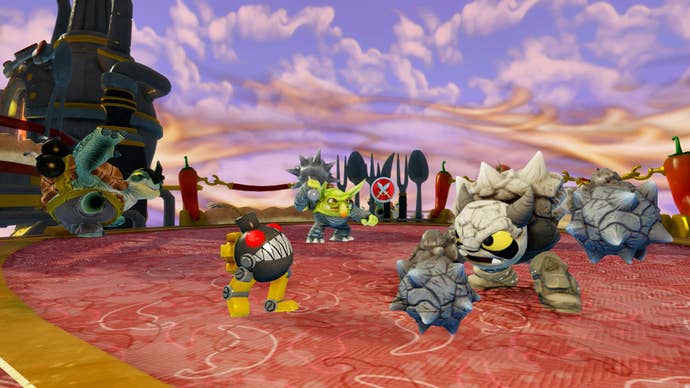
Perhaps not surprisingly, the genesis of most of Skylanders' cast lies with Reiche himself. He comes up with many of the ideas for the characters, which the team then refines and defines.
"I'm currently in love with Chopper," he says fondly, "because he's all my fantasies wrapped up together. He's a baby dinosaur with helicopter blades and robot legs and a rocket launchers." Again, Reiche laughs with a sort of good-natured humility. "It's almost like I was drawing as a seven-year-old. We've got a lot of good guys this year, but he's my favorite."
It's good to play together
There's a surprising purity behind Skylanders. More than just a business for Toys for Bob, the franchise lies somewhere between passion project and crusade. Reiche and his team speak of their audience in almost parental terms, using language that's at once affectionate and protective. For example, the team is interested in expanding the go-anywhere/do-anything nature of the games by exploring cloud computing features — but only once they can do so in a way that's safe for young players. "There are certain things you wouldn't ever want to do with our audience, like expose their location — we wouldn't want to do that," he says.
Reiche constantly circles back to the concept of play and togetherness. In fact, his enthusiasm for the subject calls to mind Nintendo's constant messaging about the appeal of playing together, which makes the Japanese giant's decision not to jump on an exclusivity deal for Skylanders somewhat mystifying. On the other hand, it's nice to see that there's more than one major studio dedicated to that sort of positive, collaborative sharing.
Reiche praises positivity in general. "I like heroic conflict," he says. "I prefer that it's expressed in terms of something colorful, whether that's spaceships or monsters. I want players to feel like the hero. There's lots of people who do great antihero stuff, and more power to them. But that's not what I'm interested in. I want people to feel like they can make a contribution, directly, to saving the day or creating something awesome.
"We also don't like hierarchy very much. Well, the Ur-Quan Hierarchy aside," (and here Reiche pauses to chuckle at his own esoteric self-reference) "I don't like coming into the game and being greeted, 'Welcome to the conflict, private. You slime! Now do this...!' I don't want to be the private! I want to find my own heroic path. So in Star Control, yes you're young, yes you don't know what you're doing, but everyone's looking to you to be the hero immediately and you have to rise to the occasion.
"In Skylanders, there is no hierarchy. One year you have Swap Force, one year you have Giants, one year you have Trap Masters. They're the new graduates from the academy and they're just as awesome everyone who came before — we try to be egalitarian. You've got Eon, the big floating head, always talking about stuff. You've got Chaos screaming over here. But really, you are authorized to be the hero the moment you put the toy on the Portal."
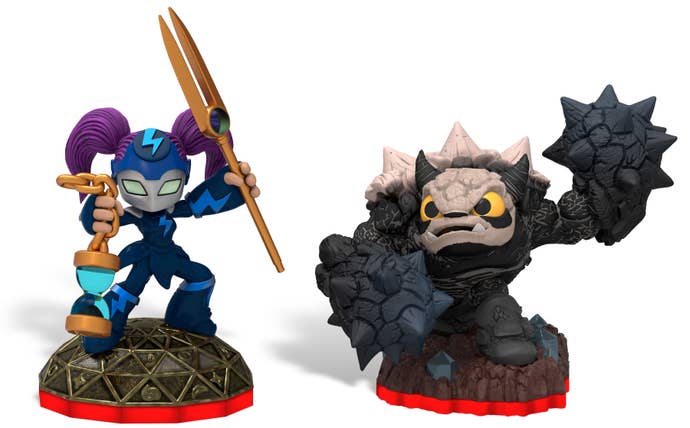
That egalitarianism manifests in reverse as well. The Skylanders team has made a commitment to ensure existing figures with be compatible with each new generation. (Even 20 years down the line, I ask? Reiche laughs. "I'll retire at year 19 and let some other young person handle that problem.") First-generation Skylanders figures can hold their own in the Trap Team, the same as the newcomers designed specifically for this fourth-generation title. It's a commitment that's borne from monetary considerations ("People can be confident that what they buy will continue to be useful years later,") as simply honoring fans' personal connections. Reiche says he's always thinking back to his own entrée into sci-fi and fantasy and trying to offer the same opportunities to Skylanders fans.
"[It's essential] to find your entry point into the world," says Reiche. "Conan is a great entry point. Frodo is a great entry point. Elric is a great entry point. But you're going to find that you gravitate toward or the other. We can all share our love of Lord of the Rings whether Aragorn is your guy or Gandalf is my guy. With Skylanders, we give you hundreds of access points. Male, female, monstrous, silly, tiny, cute. We want you to find the crystalline catalyst, something that makes you love the whole Skylanders world and get involved and, hopefully, then branch out to other characters."
Go where the players are
This inclusive, respective, enthusiastic perspective has helped Skylanders grow into one of the biggest game series around. For kids, it ranks among a handful of god-tier franchises, right alongside Minecraft, Pokémon, LEGO superheroes, and Angry Birds.
This, in turns brings us back to Reiche's claims of being on the front lines of gaming. The Skylanders team is well aware that for many newcomers to the medium, their games represent a first experience with the medium. If the games come off as too simplistic for seasoned players, that's by design; Skylanders is meant to teach newcomers the ropes of video game logic even as it entertains.
This year's installment, Trap Team, embraces that audience in a big way. When it ships next week, it will be the first major, AAA-calibre video game release to debut day-and-date on both console and tablet. Skylanders: Trap Team on tablet is not a companion app or a watered-down simplification like the Game Boy Color renditions of 32-bit shooters from 15 years ago. It's not a second-screen interface tweak. It's the full-featured game, almost indistinguishable from the PlayStation 4 version but for the loss of some minor visual details.

"Our mantra is 'Go where the players are,'" says Reiche. "We know kids are growing up now playing on tablets, and in some cases iPod Touches. Players arrive at Skylanders as their first AAA experience. Many of them are arriving with tablets as their primary experience.
"What we're trying to do is meet them where they are, not convince them to abandon their preferences entirely and go get this other thing. We have a great console business — we'll always have that. But we want to see if there's a bunch of people there who want to play a big exciting game on tablets, and so far the response is really good. I think a lot of that has to do with the implementation — they've done a good job."
In hindsight, it seems like the most obvious decision in the world. Kids are learning to play games through Skylanders, and they're learning to use digital devices with tablets (to the point that preschoolers find themselves baffled by the Nintendo 3DS; why doesn't the top screen respond when they touch it, they ask?). Bringing the two together makes perfect sense.
But it's also never properly been done, either. Skylanders, though, has its own built-in advantage to make it work: The Portal. Players can't play Skylanders without buying the electric Portal device that allows them to bring their figurines into the game; so why not simply create a portal that connects to a tablet? The tablet portal also comes with a fairly solid console-style controller that docks in its underside when not in use, allowing players to experience tablet-based Skylanders with a more traditional control scheme. But in recognition of the fluid, on-the-go nature of tablets, Skylanders also allows players to detach from the Portal and use virtual controls as needed. It's the ultimate as-you-like-it play experience, which seems a logical complement to the dynamic swap-and-play mechanics made possible by Skylanders' reliance on figures (which of course work with any version of game on any system, even tablets).

Skylanders really is staking out the front lines of gaming, offering a packaged, retail, tablet-based video game. Should it succeed, though, it's not hard to imagine many other publishers following suit, treating tablets as simply another retail SKU for their big console releases.
As for Reiche and his team, they seem satisfied in sticking to their existing plan. It's all about kids, and all about creatures — no matter how bizarre. "If we create an artichoke, awesome, " says Reiche. "If we come up with an undead ghost who's scared of other ghosts, fantastic."
Reiche pauses. "That one doesn't exist yet, but I think it's a good idea," he muses, possibly offering the world's first inside scoop on what Skylanders fans can look forward to in 2015.

